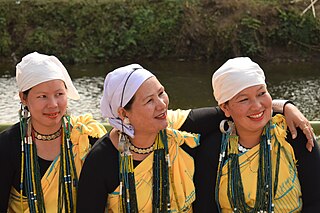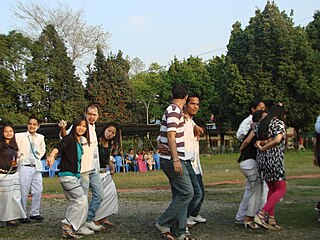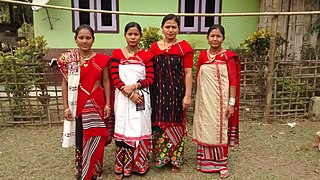Lhoba is any of a diverse amalgamation of Sino-Tibetan-speaking tribespeople living in and around Pemako, a region in southeastern Tibet including Mainling, Medog and Zayü counties of Nyingchi and Lhünzê County of Shannan, Tibet.

Arunachal Pradesh is a state in northeast India. It was formed from the North-East Frontier Agency (NEFA) region, and India declared it as a state on 20 February 1987. Itanagar is its capital and largest town. It borders the Indian states of Assam and Nagaland to the south. It shares international borders with Bhutan in the west, Myanmar in the east, and a disputed 1,129 km border with China's Tibet Autonomous Region in the north at the McMahon Line.

Itanagar is the capital and largest town of the Indian state of Arunachal Pradesh. The seat of Arunachal Pradesh Legislative Assembly, the seat of government of Arunachal Pradesh, and the seat of Gauhati High Court permanent bench at Naharlagun are all in Itanagar. Being the hub of all the major economic bases, Itanagar, along with the adjacent town of Naharlagun, comprise the administrative region of the Itanagar Capital Complex Region. This stretches from the Itanagar Municipal limit at Chandranagar Town extended until Nirjuli Town, and is a major junction of cultural, economic, fashion, education and recreational activities.

The Adi people are one of the most populous groups of indigenous peoples in the Indian state of Arunachal Pradesh. A few thousand are also found in the Tibet Autonomous Region, where they are called the Lhoba together with some of the Nyishi people, Na people, Mishmi people and Tagin people.

The Apatani or Tani are a tribal group of people living in the Ziro valley in the Lower Subansiri district of Arunachal Pradesh in India. This tribe speaks the languages Apatani, English and Hindi.

Donyi-Polo is the designation given to the indigenous religion, of animistic and shamanic type, of the Tani and other Tibeto-Burman peoples of Arunachal Pradesh and Assam in Northeast India. The name "Donyi-Polo" means "Sun-Moon", and was chosen for the religion in the process of its revitalisation and institutionalisation. Donyi-Polo has been there since time immemorial.
The buru or bura is an aquatic cryptic animal featured in a foundation myth of the Apatani people. Stories of the migration of the Apatani to their present location in the Ziro Valley of Arunachal Pradesh tell of a swamp occupying the valley, inhabited by fierce, crocodile-like creatures. Draining the swamp and destroying the creatures allowed them to cultivate fertile paddy fields and settle the valley.

Pasighat is the headquarters of East Siang district in the Indian state of Arunachal Pradesh. Situated at the eastern foothills of the Himalayas at 155 meters (509 ft) above mean sea level, Pasighat is Arunachal's oldest town. The Government of India included Pasighat in the Smart Cities Mission development scheme in June 2017.

Yingkiong is a town in and the administrative headquarters of Upper Siang district in the Northeast Indian state of Arunachal Pradesh. It is located 250 kilometres (160 mi) north of Itanagar, the capital of the state, and 1 kilometre (0.62 mi) east of the River Siang. According to the 2011 Census, the town has a total population of 8,573.
Tani, is a branch of Sino-Tibetan languages spoken mostly in Arunachal Pradesh, Assam, and neighboring regions.
Padam is a sub-tribe of the Adi tribe of Abotani clan which speaks one of the Sino-Tibetan languages. Padam makes up 30–35% of the Adis and are the strongest sub-tribe of the Adis. They were a nomadic warrior race and used to had a reputation as fierce warrior by pre colonial period, they are believed to have migrated to present Arunachal Pradesh from Tibet. They were also known by the name Bor Abors in the past by their Assam counterparts and the British government.
Talom Rukbo (1937–2001) was the father of Donyi-Polo, a revivalist religious movement based in Arunachal Pradesh which attempts to reconstruct Tani (Adi) animist spirituality.
The Tani people are a Sino-Tibetan ethnic group of people from the Indian states of Arunachal Pradesh, Assam, and the Tibet Autonomous Region of China. They share common beliefs, language and ancestry with the Abotani. Nyishi, Adi, Apatani, Galo, Tagin, and Mising are the members of Tani ethnic group.
Murung is the Festival of Prosperity, celebrated by the Apatanis of Lower Subansiri district in Arunachal Pradesh, India. Though an individual festival, whole villages and indeed the whole of the Apatani people get involved in the festival. It is celebrated in the Month of January or Murung piilo. Besides it the Apatanis also celebrate Myoko in the month of march and the Dree Festival from 4 to 7 July every year.

The Galo are a tribe in Arunachal Pradesh, who are descendants of Abotani. They speak the Tani Galo language. Other names which have been used to reference the Galo tribe in the past include Duba, Doba, Dobah Abor, Gallong Abor, Galong, Gallong Adi, etc. The Galo have been listed as a scheduled tribe under the name Gallong since 1950.
The Apatanis who inhabit a tranquil pine clad valley called Ziro at the core of Lower Subansiri District of Arunachal Pradesh, are famous for their unique practice of wet rice cultivation. They are also known for their sustainable agricultural practices and the agricultural cycles govern their everyday lives. The agricultural festival of Dree is the highlight in this cycle.
The type of the dishes of the Indian state of Arunachal Pradesh vary within the region, according to tribal influence

The 'Mopin' or 'Moopin' Festival is an agricultural festival celebrated by the Galo tribe of Arunachal Pradesh, India in particular of the Galo group of tribes which resides in East Siang and West Siang districts. It is a celebration of the harvesting season held in the Galo months of "Lumi" and "Luki", corresponding to March–April and the new year for the Galo tribe. The Galo tribe follow an animist religion called Donyi-Polo.

The Mising people, sometimes called Miri people, are a Tibeto-Burmese indigenous ethnic group inhabiting the Northeast Indian states of Assam and Arunachal Pradesh. They are part of Tani group of people of Northeast India.
Marriage Practices of Galo Tribe or Traditional Galo Tribe Wedding/Marriage Practices are part of the cultural fabric of Arunachal Pradesh, India. In Galo dialect, it is called as NYIDA.









